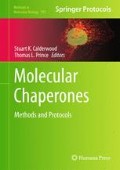Abstract
The enzyme-linked immunosorbent assay (ELISA) is an immunological technique which is used to determine the presence or quantity of an antigen within a sample. ELISAs rely on the use of at least one antibody (Ab) specific for the antigen being measured. This antibody is covalently linked to an enzyme which is detected through the use of an enzymatic substrate, which can be colorimetric, fluorogenic, or chemiluminescent. The ELISA for Hsp72 described here is a typical indirect sandwich ELISA, which can be used for measuring Hsp72 from cellular/tissue extracts, tissue culture supernatant, and serum. Typically, a 96-well ELISA plate is coated with a specific antibody which captures Hsp72 from the sample, and another antibody specific for a different Hsp72 epitope is used to detect Hsp72. An enzyme-labelled species-specific antibody conjugate is then applied which is consequently detected using a colorimetric enzyme substrate. The quantity of Hsp72 present in the samples is interpolated using a standard curve of known amounts of pure Hsp72.
Access this chapter
Tax calculation will be finalised at checkout
Purchases are for personal use only
References
Ireland, H. E., Leoni, F., Altale, O., Birch, C. S., Coleman, R. C., Hunter-Lavin, C., and Williams, J. H. H. (2007) Measuring the secretion of heat shock proteins from cells, Methods 43, 176–183.
Njemini, R., Lambert, M., Demanet, C., and Mets, T. (2003) Elevated serum heat-shock protein 70 levels in patients with acute infection: use of an optimized enzyme-linked immunosorbent assay, Scand J Immunol 58, 664–669.
Njemini, R., Demanet, C., and Mets, T. (2005) Comparison of two ELISAs for the determination of Hsp70 in serum, J Immunol Methods 306, 176–182.
Fehrenbach, E., Passek, F., Niess, A. M., Pohla, H., Weinstock, C., Dickhuth, H. H., and Northoff, H. (2000) HSP expression in human leukocytes is modulated by endurance exercise, Med Sci Sport Exer 32, 592–600.
Walsh, R. C., Koukoulas, I., Garnham, A., Moseley, P. L., Hargreaves, M., and Febbraio, M. A. (2001) Exercise increases serum Hsp72 in humans, Cell Stress Chaperon 6, 386–393.
Dempsey, N. C., Leoni, F., Ireland, H. E., Hoyle, C., and Williams, J. H. H. (2010) Differential heat shock protein localization in chronic lymphocytic leukemia., J Leukocyte Biol 87, 467–476.
Njemini, R., Demanet, C., and Mets, T. (2003) Determination of intracellular heat shock protein 70 using a newly developed cell lysate immunometric assay, J Immunol Methods 274, 271–279.
Wright, B. H., Corton, J. M., El-Nahas, A. M., Wood, R. F. M., and Pockley, A. G. (2000) Elevated levels of circulating heat shock protein 70 (hsp70) in peripheral and renal vascular disease, Heart Vessels 15, 18–22.
Dempsey, N. C., Ireland, H. E., Smith, C. M., Hoyle, C. F., and Williams, J. H. H. (2010) Heat Shock Protein translocation induced by membrane fluidization increases tumor-cell sensitivity to chemotherapeutic drugs, Cancer Lett doi:10.1016/j.canlet.2010.04.016 DOI:dx.doi.org.
Terry, D. F., Wyszynski, D. F., Nolan, V. G., Atzmon, G., Schoenhofen, E. A., Pennington, J. Y., Anderson, S. L., Wilcox, M. A., Farrer, L. A., Barzilai, N., Baldwin, C. T., and Asea, A. (2006) Serum heat shock protein 70 level as a biomarker of exceptional longevity, Mech Aging Dev 127, 862–868.
Pockley, A. G., Shepherd, J., and Corton, J. M. (1998) Detection of heat shock protein 70 (hsp70) and anti-hsp70 antibodies in the serum of normal individuals, Immunol Invest 27, 367–377.
Rea, I. M., McNerlan, S., and Pockley, A. G. (2001) Serum heat shock protein and anti-heat shock protein antibody levels in aging, Exp Gerontol 36, 341–352.
Fukushima, A., Kawahara, H., Isurugi, C., Syoji, T., Oyama, R., Sugiyama, T., and Horiuchi, S. (2005) Changes in serum levels of heat shock protein 70 in preterm delivery and pre-eclampsia, J Obstet and Gynaecol Res 31, 72–77.
Zhu, J. H., Quyyumi, A. A., Wu, H. S., Csako, G., Rott, D., Zalles-Ganley, A., Ogunmakinwa, J., Halcox, J., and Epstein, S. E. (2003) Increased serum levels of heat shock protein 70 are associated with low risk of coronary artery disease, Arterioscl Throm Vas 23, 1055–1059.
Mambula, S. S., and Calderwood, S. K. (2006) Heat induced release of hsp70 from prostate carcinoma cells involves both active secretion and passive release from necrotic cells, Int J Hyperther 22, 575–585.
Murray, K. S., Rouse, J. C., Tangarone, B. S., Peterson, K. A., and Van Cleave, V. H. (2001) Identification of human serum interferants in the recombinant P-selectin glycoprotein ligand-1 clinical ELISA using MALDI MS and RP-HPLC, J Immunol Methods 255, 41–56.
Nemzek, J. A., Siddiqui, J., and Remick, D. G. (2001) Development and optimization of cytokine ELISAs using commercial antibody pairs, J Immunol Methods 255, 149–157.
Author information
Authors and Affiliations
Corresponding author
Editor information
Editors and Affiliations
Rights and permissions
Copyright information
© 2011 Springer Science+Business Media, LLC
About this protocol
Cite this protocol
Ireland, H.E., Williams, J.H.H. (2011). Measuring Hsp72 (HSPA1A) by Indirect Sandwich ELISA. In: Calderwood, S., Prince, T. (eds) Molecular Chaperones. Methods in Molecular Biology, vol 787. Humana Press. https://doi.org/10.1007/978-1-61779-295-3_12
Download citation
DOI: https://doi.org/10.1007/978-1-61779-295-3_12
Published:
Publisher Name: Humana Press
Print ISBN: 978-1-61779-294-6
Online ISBN: 978-1-61779-295-3
eBook Packages: Springer Protocols

